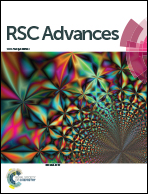First-principles study on the electric structure and ferroelectricity in epitaxial CsSnI3 films†
Abstract
Ferroelectricity is a potentially crucial issue in inorganic halide perovskites, which are breakthrough materials in photovoltaic research. However, to date, conclusive evidence for ferroelectricity in all-inorganic halide perovskites is still lacking. Herein, using density functional theory simulations and symmetry analysis, it is found that two stable ferroelectric phases, P4bm and Pmc21-(I), can be induced by compressive and tensile strain in all-inorganic halide perovskite CsSnI3 films. More importantly, the calculated polarization value is as high as several μC cm−2 which is desirable for the separation of photo-excited carriers in these materials. In addition, it is found that the P4bm phase has an indirect band gap and the Pmc21-(I) phase has a suitable direct band gap for the absorption of visible light. In particular, tensile strain can alter the band gaps by several tenths of an electronvolt in the Pmc21-(I) phase. Overall, these results give useful insight for strained CsSnI3 films and hopefully provide a new route to design ferroelectric semiconductors for photovoltaic materials in the less-explored inorganic halide perovskites.



 Please wait while we load your content...
Please wait while we load your content...